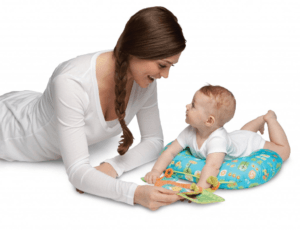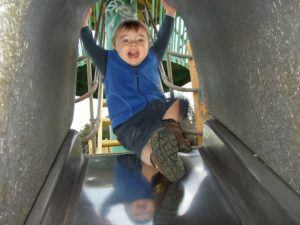Gross Motor Skills
Why is tummy time important?
February 18, 2018 / Diane L Crecelius, PT, CEO
Today parents are offered so many options for positioning for their babies. You can place your baby in a swing, in a bouncy seat, in a stroller, in a car seat, in a Bumbo seat, in a Johnny jump up and in a high chair.
Actually, the best place for your baby when not in your arms is on the floor. This gives your child the opportunity to explore their new world. Place you child on their back under a baby gym so they can reach and play. This will help your baby to discover their hands and improve eye hand coordination.
Now, play on the tummy. This is very important. Why? Let me explain.
 Lying on the belly requires that an infant be able to lift his/her head (this is called extension of the neck) progressing to propping on forearms (more extension now involving the upper half of the back) followed by propping on straight arms (even more extension of the back).
Lying on the belly requires that an infant be able to lift his/her head (this is called extension of the neck) progressing to propping on forearms (more extension now involving the upper half of the back) followed by propping on straight arms (even more extension of the back).
Tummy time gives the child a different visual field to look at and explore.
The strength and endurance required to maintain your position on your belly as well as to weight shift to lift an arm and move is very difficult. Babies often resist this position for an easier position of flexion – lying on their back or snuggling on their parent’s chest.
The head/neck control a baby gains while playing on their tummy allows them to have more success with being held upright as well as gaining the skill of sitting.

Strength in the trunk (the back and belly) helps a child progress to sitting on their own. A balance is needed between the belly, neck and back muscles (flexion and extension) as well as arm strength in order to have success with sitting.
When a child first begins to sit, he/she will prop on straight arms. This arm strength was gained during tummy time propping on first bent then straight arms.
Fun tip: Try this yourself! Lie on your belly and prop on your forearms and then on straight arms. Feel how hard it is to prop on straight arms. Now you can understand why your child might resist this position. Also, you can understand how much strength arms can develop in this position.
Another fun tip: First lie flat on your belly with you arms flat at your sides. Lift your head and look around you. Now prop on your forearms and look around. Finally, prop on extended arms and look around. Notice how your visual field (what you see) changes. This is important for a child to expand what they see as well as to mature their vestibular system (the ability of the senses within your head to adjust to changes in position).
Developmentally, a child progresses from sitting propped on straight arms to weight shifting and reach with each arm to play. This weight shift and reach was first learned while on their tummy.
Ultimately, a child will begin to sit with hands free. This means the child has achieved a balance of strength and endurance of the muscles in their neck, back and belly (their trunk) allowing the child to maintain an upright sitting position for functional play.
Continue to challenge your child’s development by seeking out the knowledge on how to push their progress to each next step.
For all your child’s developmental checklists go to www.abcpediatrictherapy.com.
Read MoreSqueeze in some fun outside activities this weekend while we still have some warm weather!! As you know, outdoor activities are a great way for children to stay fit as well as release some excess energy. Here are some gross motor activities that promote strength, motor planning, balance, reaction time and coordination.
Finding a good jungle gym is often hard to find! Sharon Woods and Winton Woods are parks in Hamilton county with fantastic jungle gyms. Pine Hills Park, Heritage Park, Corwin Nixon Park and Fleckinstein Park have great jungle gyms in Mason. West Chester and Liberty Township have very fun jungle gyms as well as Fort Liberty Park and Keehner park.
When climbing up and down a jungle gym ladder, encourage your child to have their stomach against the ladder. This makes all the right muscles work. Going up is typically no problem but be careful when your child is learning to come down a ladder. Your child may need verbal cues to look where they are placing their feet. He/she may need manual help to find the step.
Have your child climb up a slide. This encourages strengthening in the hands and legs. It also requires them to be aware of their own safety. Encourage them to look to the top of the slide first to be sure no one is there.
Monkey bars not only develop upper body strength but also encourages motor planning and weightshift so they can move across the length of the bars.
Swinging on a strap swing is grat for grip strength, trunk and abdominal stengthening and even motor planning in order to propel the swing.
Read More Skip to content
Skip to content

